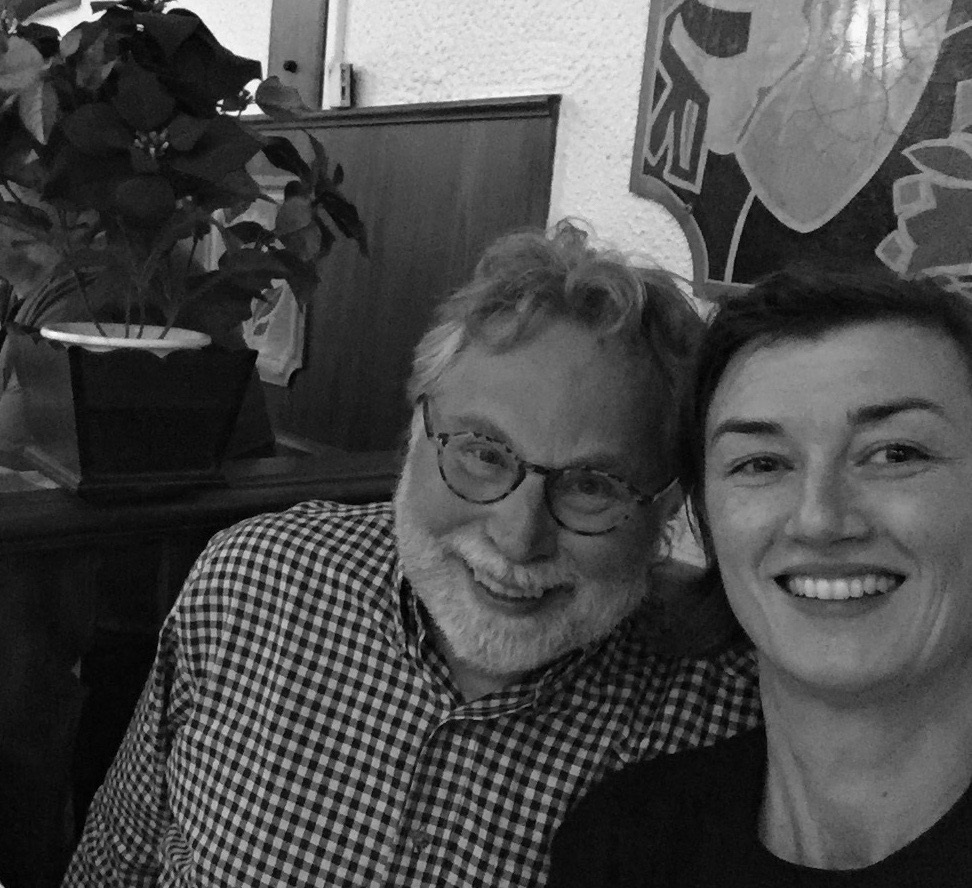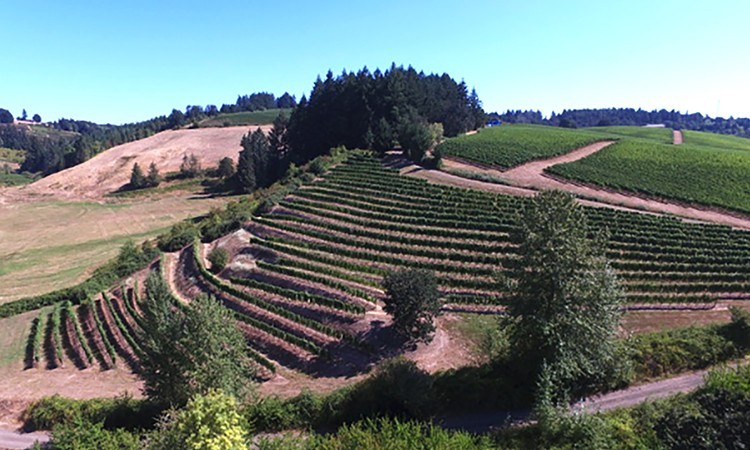St. Innocent, Willamette Valley
California Sales Only

| Region | Oregon |
| Appellation | Willamette Valley |
| Producer | Mark Vlossak |
| Founded | 1988 |
| Website | https://stinnocentwine.com/ |
These judiciously oaked Pinots, which in this case do not show like the spawn of hot years, are consistently in the upper tier of New World Pinot Noir, especially if one favors elegance over power. Vlossak’s pricing regimen is also truly Old World in its fairness, which deserves a tip of the hat.
—Josh Raynolds, Vinous Media, February 2022
Mark Vlossak grew up tasting wine at the side of his father, who imported fine wine on the side for a group of buddies in a wine club (the container truck would pull up to the house in Wisconsin once a year and all these guys would unload the wine, distribute it among themselves, and throw a party). After a postgraduate degree in medicine, he moved to Oregon to practice pediatrics. In 1983, he re-discovered his passion for wine, which led to school at UC Davis as well as a two-year apprenticeship at Oregon’s Arterberry Winery. In 1988, he founded St. Innocent Winery, named for his father, who was born on All Innocent’s Day and christened with the middle name of Innocent.
He’s long been guided by a European sensibility. Ten years after starting his winery, he went to Burgundy on the first of many such trips, where he came to understand that the innate qualities of great Pinot Noir don’t come from the more-is-better philosophy that guided so many of his new world peers back in those days. Intensity of extraction, for example, didn’t result in a more powerful wine (just a bigger, clunkier one). By the turn of the century, he was known for wines of nuance and layered richness, many from what are now among Oregon’s most respected sites.

Mark (pictured above with Mélanie Pfister having lunch in Alsace, 2019) was the winemaker at Panther Creek from 1994 until 1999, when he was able to go full time with St. Innocent. In 2007 he moved out of the tiny winery he had built in an industrial park in Salem (a practical place without a shred of romance) to a state-of-the-art facility deep in the Eola-Amity Hills. It was called Zenith Vineyards, and St. Innocent bought an interest in this LLC during its conceptual phase, allowing Mark to design the cellar from start to finish. In 2017, wishing to be unencumbered by partners, he sold his share in Zenith and bought a small property in the south Salem hills.
There, with the help of a friend, the viticulturist Mimi Casteel, he planted a vineyard, plus an apple orchard, and built a new winery. He’s come full circle back to owning his own place, with the enormous plus of having a vineyard. He planted it one vine at a time via a drilled hole, all 15.5 acres—without earth-moving equipment, bulldozing, or grading, meaning that virtually none of the soil and its microbial life was exposed to light or oxygen—and made the parcels organic from the start (now he’s talking with Moe Momtazi to determine biodynamic preparations).

In the process, he’s downsized his production by nearly 40%. His focus remains on Pinot Noir—it comprises some 70% of what he makes—from the Freedom Hill, Momtazi, Shea (pictured above), and Temperance vineyards. In addition, there’s a bit of Chardonnay and Pinot Blanc.
The Wines
| Wine | Blend | Description |
|---|---|---|
| Freedom Hill, Willamette Valley | Pinot Blanc | The Freedom Hill Vineyard was first planted in 1982 by Dan and Helen Dusschee in the Willamette Valley AVA (it’s actually in the Eola Amity hills, but just outside the southwestern border of that AVA). Phylloxera reared its ugly head in 1995, necessitating a painful replanting, but also giving the Dusschees, now veteran viticulturalists, a welcome chance to completely change spacing, trellising, and orientation. The vineyard is one of the state’s most western, a warm site facing east but with quite cold nights, growing in ancient marine sediments. The Dusschee’s kids, Dustin and McKenzie, are taking over the management of the vineyard. Mark first made Pinot Blanc from Freedom Hill in 1997. These days the wine is a mix from tank with a fifth to a quarter from 1,000-liter Solvenian acacia foudres, blended after eight months of aging on its lees. Malo typically happens naturally. Production averages 400 cases. |
| Freedom Hill, Willamette Valley | Chardonnay | Mark has been making Chardonnay from this site since 1992. He works with two blocks of Dijon clones, one planted in 1999 and the other in 2006. Over the years he has modified his winemaking, and now lets his ferments start spontaneously without SO2 or bacteria additions (a small amount of SO2 is added at bottling). Ageing is for twelve months on the lees—no stirring—in entirely neutral barrels, which are never moved once wine is inside of them. No fining, only a light filtration, and bottled by gravity. Production averages 1,100 cases. |
| Freedom Hill, Willamette Valley | Pinot Noir | The first vintage of Freedom Hill Pinot Noir for St. Innocent was 1994. Today he works with three blocks: two acres of Pommard; two acres of Wädenswil; and three acres of 777. The fruit for this (and all St. Innocent Pinot Noir) is de-stemmed but only minimally crushed, leaving 30-40% whole berries, and fermentations begin spontaneously in large wooden uprights without SO2. After several days, an extremely small amount of a mild strain of German yeast is added to the side of a fermenter, without being mixed in; this is Mark’s insurance policy against stuck ferments (which can require radical interventions), and the amount and strength of the yeast is such that it is not an inoculation so much as a reinforcement for the fermentations that have already begun. Aging is for 11-15 months in barrel with a maximum of 30% new wood. No fining, only a light filtration, and bottling is done by gravity. Note that all of St. Innocent Pinot Noirs open significantly with air, and decanting is recommended. Freedom Hill consistently produces some of the state’s most distinctive Pinot Noirs, with muscular structure, drive, and dark fruit profiles. Saint Innocent’s production averages just under 1,000 cases. |
| Momtazi, Willamette Valley | Pinot Noir | Moe Momtazi got his engineering degree in the US, returned to Iran, and then fled after the revolution. With his pregnant wife, he made his way back in the US via Mexico, and applied for political asylum. They ended up in Oregon, where Moe started a construction firm, and then in 1997 bought an abandoned wheat farm that had sat idle for seven years. His father and grandfather had made wine in Iran, and this was a way to return to his roots. From the beginning, he put in his vineyard parcels without conventional chemicals, and by 2004 all of the vines (now 260 acres) were certified biodynamic by Demeter. Mark first made Pinot Noir from the Momtazi Vineyard in 2006. He works with five blocks, a total of 8.1 acres, mostly clone 777 with 115, 667, and Pommard. These vines are the highest on Momtazi’s steep hillside at 680-760 feet above sea level. As with Freedom Hill, the soils are uplifted marine sedimentary loams and silts, mixed with volcanic soils (admittedly, this is odd; back when this land was ocean floor, a volcanic eruption cracked the seabed, and lava poured out, mixing with the sedimentary soil). But at Momtazi the topsoil is much more shallow than at Freedom Hill, especially higher up the hillside. Plus, the afternoon wind is a force to reckon with. The site is seven miles west of McMinnville, on the north side of the Van Duzer Corridor that cuts through the coastal range and funnels cold air into the Willamette Valley. With the first scent of this wine, the extremes of exposure, temperature shifts, and shallow soils make themselves felt—the aromatics grab you and demand attention. Production ranges from 900 to 1,100 cases. |
| Shea, Yamhill-Carlton | Pinot Noir | Dick Shea got his first crop from his vines in 1989, and today his vineyard has 140 acres, selling fruit to a who’s who of Oregon producers. Farming is sustainable, and for the ten years that Shea participated in USDA’s Conservation Security Program it made the top 5% of farms who were awarded best practices. Mark made his first Shea Pinot Noir in 1994. His grapes come from 6.3 acres in two hillside parcels, both growing in shallow marine sedimentary soils. One parcel faces southeast at 450-500 feet, planted with Pommard and 115, and the other faces southwest on a very steep slope planted with the Pommard clone. The wine is consistently full-bodied, complex, and age-worthy. Production averages 1,000 cases. |
| Temperance Hill, Eola-Amity | Pinot Noir | Temperance was established in 1981 and since 1991 has been managed by Dai Crisp, who moved it to an organic footing. It was certified in 2012 (and is certified salmon safe). It’s the highest vineyard in the Eola-Amity AVA, and the coolest of the sites that St. Innocent sources, losing direct sunlight by 5 or so in the afternoon. The vines grow along the spine of the Eola-Amity hills in and around a caldera of an ancient volcano. The volcanic soils are a mix of Nekia, Rittner, and Jory. Some 25 wineries source from its 100 acres of vines. Mark made his first Pinot Noir from Temperance in 1994. He works with 6.5 acres in two blocks, ranging from 650 to nearly 850 feet, mostly planted in dense parcels to Pinot Noir (Pommard, Wädenswil, and 667). The wine is classic Eola-Amity with its balance, spice, and perfume. Production averages 1,000 cases. |